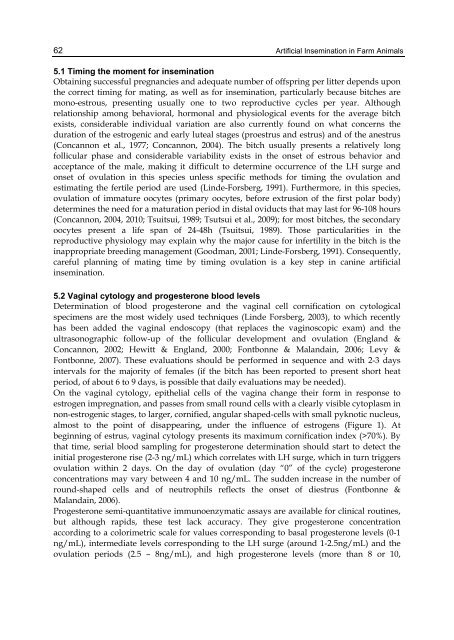ARTIFICIAL INSEMINATION IN FARM ANIMALS - Phenix-Vet
ARTIFICIAL INSEMINATION IN FARM ANIMALS - Phenix-Vet
ARTIFICIAL INSEMINATION IN FARM ANIMALS - Phenix-Vet
Create successful ePaper yourself
Turn your PDF publications into a flip-book with our unique Google optimized e-Paper software.
62Artificial Insemination in Farm Animals5.1 Timing the moment for inseminationObtaining successful pregnancies and adequate number of offspring per litter depends uponthe correct timing for mating, as well as for insemination, particularly because bitches aremono-estrous, presenting usually one to two reproductive cycles per year. Althoughrelationship among behavioral, hormonal and physiological events for the average bitchexists, considerable individual variation are also currently found on what concerns theduration of the estrogenic and early luteal stages (proestrus and estrus) and of the anestrus(Concannon et al., 1977; Concannon, 2004). The bitch usually presents a relatively longfollicular phase and considerable variability exists in the onset of estrous behavior andacceptance of the male, making it difficult to determine occurrence of the LH surge andonset of ovulation in this species unless specific methods for timing the ovulation andestimating the fertile period are used (Linde-Forsberg, 1991). Furthermore, in this species,ovulation of immature oocytes (primary oocytes, before extrusion of the first polar body)determines the need for a maturation period in distal oviducts that may last for 96-108 hours(Concannon, 2004, 2010; Tsuitsui, 1989; Tsutsui et al., 2009); for most bitches, the secondaryoocytes present a life span of 24-48h (Tsuitsui, 1989). Those particularities in thereproductive physiology may explain why the major cause for infertility in the bitch is theinappropriate breeding management (Goodman, 2001; Linde-Forsberg, 1991). Consequently,careful planning of mating time by timing ovulation is a key step in canine artificialinsemination.5.2 Vaginal cytology and progesterone blood levelsDetermination of blood progesterone and the vaginal cell cornification on cytologicalspecimens are the most widely used techniques (Linde Forsberg, 2003), to which recentlyhas been added the vaginal endoscopy (that replaces the vaginoscopic exam) and theultrasonographic follow-up of the follicular development and ovulation (England &Concannon, 2002; Hewitt & England, 2000; Fontbonne & Malandain, 2006; Levy &Fontbonne, 2007). These evaluations should be performed in sequence and with 2-3 daysintervals for the majority of females (if the bitch has been reported to present short heatperiod, of about 6 to 9 days, is possible that daily evaluations may be needed).On the vaginal cytology, epithelial cells of the vagina change their form in response toestrogen impregnation, and passes from small round cells with a clearly visible cytoplasm innon-estrogenic stages, to larger, cornified, angular shaped-cells with small pyknotic nucleus,almost to the point of disappearing, under the influence of estrogens (Figure 1). Atbeginning of estrus, vaginal cytology presents its maximum cornification index (>70%). Bythat time, serial blood sampling for progesterone determination should start to detect theinitial progesterone rise (2-3 ng/mL) which correlates with LH surge, which in turn triggersovulation within 2 days. On the day of ovulation (day “0” of the cycle) progesteroneconcentrations may vary between 4 and 10 ng/mL. The sudden increase in the number ofround-shaped cells and of neutrophils reflects the onset of diestrus (Fontbonne &Malandain, 2006).Progesterone semi-quantitative immunoenzymatic assays are available for clinical routines,but although rapids, these test lack accuracy. They give progesterone concentrationaccording to a colorimetric scale for values corresponding to basal progesterone levels (0-1ng/mL), intermediate levels corresponding to the LH surge (around 1-2.5ng/mL) and theovulation periods (2.5 – 8ng/mL), and high progesterone levels (more than 8 or 10,










